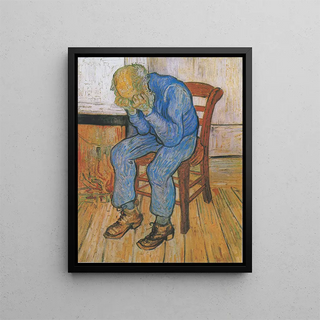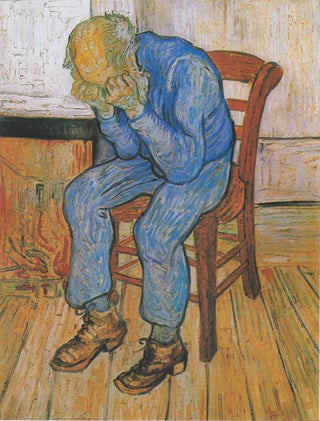Art print | At the door of eternity - Vincent van Gogh


View from behind

Frame (optional)
"At the Gate of Eternity", an iconic work by Vincent van Gogh, invites viewers into a profound immersion into the artist's turbulent universe. Painted in 1890, this canvas is often seen as a reflection of Van Gogh's internal struggles, while offering a poignant vision of the quest for eternity. The painting, depicting human silhouettes heading toward a mystical horizon, evokes a sense of transcendence and introspection. This piece, both personal and universal, encourages us to reflect on the human condition and our relationship with life and death. The art print of this work helps keep alive the memory of an artist whose legacy continues to inspire generations.
Style and uniqueness of the work
The style of "At the Gate of Eternity" is distinguished by its bold use of color and texture. Van Gogh, a master of color, applies energetic brushstrokes that infuse a unique dynamism into the composition. The vivid hues, ranging from deep blue to bright yellow, create an atmosphere that is both melancholic and vibrant. The figures, though stylized, seem charged with emotion, embodying souls in search of redemption or peace. The background, with its turmoil and movement, reinforces the feeling of a journey into the unknown. This work is not merely a visual representation; it becomes a sensory experience, a dialogue between the artist and the viewer, where each gaze reveals new layers of meaning.
The artist and his influence
Vincent van Gogh, a central figure of post-impressionism, transcended the artistic conventions of his time. His life, marked by personal struggles and an unceasing quest for meaning, is reflected in each of his works. Van Gogh established a deep connection between his art and his emotions, creating a visual language that continues to touch souls. His influence is evident in the contemporary art world, where many artists draw inspiration from his bold approach to color and form. "At the Gate of Eternity" embodies this duality between suffering

Matte finish

View from behind

Frame (optional)
"At the Gate of Eternity", an iconic work by Vincent van Gogh, invites viewers into a profound immersion into the artist's turbulent universe. Painted in 1890, this canvas is often seen as a reflection of Van Gogh's internal struggles, while offering a poignant vision of the quest for eternity. The painting, depicting human silhouettes heading toward a mystical horizon, evokes a sense of transcendence and introspection. This piece, both personal and universal, encourages us to reflect on the human condition and our relationship with life and death. The art print of this work helps keep alive the memory of an artist whose legacy continues to inspire generations.
Style and uniqueness of the work
The style of "At the Gate of Eternity" is distinguished by its bold use of color and texture. Van Gogh, a master of color, applies energetic brushstrokes that infuse a unique dynamism into the composition. The vivid hues, ranging from deep blue to bright yellow, create an atmosphere that is both melancholic and vibrant. The figures, though stylized, seem charged with emotion, embodying souls in search of redemption or peace. The background, with its turmoil and movement, reinforces the feeling of a journey into the unknown. This work is not merely a visual representation; it becomes a sensory experience, a dialogue between the artist and the viewer, where each gaze reveals new layers of meaning.
The artist and his influence
Vincent van Gogh, a central figure of post-impressionism, transcended the artistic conventions of his time. His life, marked by personal struggles and an unceasing quest for meaning, is reflected in each of his works. Van Gogh established a deep connection between his art and his emotions, creating a visual language that continues to touch souls. His influence is evident in the contemporary art world, where many artists draw inspiration from his bold approach to color and form. "At the Gate of Eternity" embodies this duality between suffering






